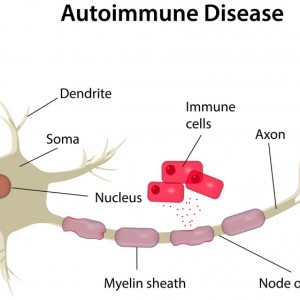March 26th, 2015 Alisa Woods, PhD
New research from Italy and Spain demonstrated that intense immunosuppression followed by autologous hematopoietic stem cell transplantation (AHSCT) was better than the medication mitoxantrone in treating severe cases of multiple sclerosis. The study appeared in the February 11, 2015, online issue of Neurology.
 MS is characterized by an immune system attack on the body’s own nerve cells. The fatty substance myelin degenerates in MS, causing problems with nerve cell communication. Mitoxantrone is an intravenous medication that inhibits immune system cells, including T-cells, B-cells, and macrophages. It can slow the progression of MS, but does not cure the disease. In contrast to the approach of using medication to inhibit the immune system, AHSCT attempts to replace the immune system. Lead author Giovanni Mancardi, MD of the University of Genoa in Italy explained “This process appears to reset the immune system. With these results, we can speculate that stem cell treatment may profoundly affect the course of the disease.”
MS is characterized by an immune system attack on the body’s own nerve cells. The fatty substance myelin degenerates in MS, causing problems with nerve cell communication. Mitoxantrone is an intravenous medication that inhibits immune system cells, including T-cells, B-cells, and macrophages. It can slow the progression of MS, but does not cure the disease. In contrast to the approach of using medication to inhibit the immune system, AHSCT attempts to replace the immune system. Lead author Giovanni Mancardi, MD of the University of Genoa in Italy explained “This process appears to reset the immune system. With these results, we can speculate that stem cell treatment may profoundly affect the course of the disease.”
Over 800 patients with MS have undergone stem cell treatments in small studies.
Dr. Mancardi and co-workers from the Autoimmune Disease Working Party of the European Group for Blood and Marrow Transplantation studied 21 patients with an average age of 36 years. All of the study participants had secondary progressive or relapsing-remitting MS and had an increased MS disability within the last year, even though they were taking standard MS treatments.
Nine of the study participants received intense immunosuppression followed by stem cell transplantation and 12 received mitoxantrone 20 mg every month for 6 months. To determine whether MS was progressing, the scientists performed magnetic resonance imaging (MRI).
The researchers studied the subjects for up to 4 years. The intense immunosupression with stem cell transplantation reduced apparent multiple sclerosis activity more than the mitoxantrone treatment. This was a statistically significant effect. People who underwent stem cell transplants had 79% fewer regions in which lesions appeared (brain damage) compared to those who received mitoxantrone. The study authors noted that “This effect was already evident in the first year and was sustained through the 4-year follow-up.”
~~~~~~~~~~~~~~~~~~~~
.
.
.
Visit our MS Learning Channel on YouTube: http://www.youtube.com/msviewsandnews



